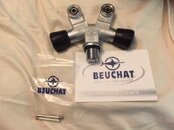2airishuman
Contributor
Really? How about shutting down the free flowing post and still having access to all of the gas not lost in a free flow?
In this situation, manifolded isolatable doubles would have been a much better option than losing ALL of his backgas. Even with tiny doubles(45's) he would have had a huge redundancy advantage.
We were discussing a comparison among H valves, Y valves, and doubles. Any of them would permit a shutdown of the freeflowing post.




